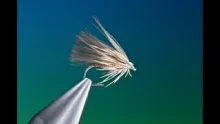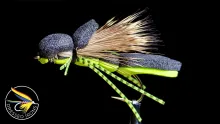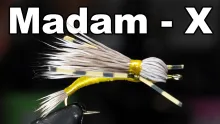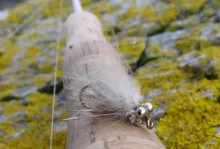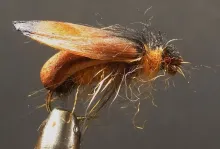A bit of stacker education and stacker philosophy is due, so here it is: quite a lot of information about hair stackers
I know that some people will find an article about hair stackers a bit exotic or even strange, but stackers belong in the category of important tools in many fly-tying toolboxes, and honestly, I think a bit of stacker education and stacker philosophy is due.
As you may know, I love to tie muddlers, and a stacker can be an important tool if you want to tie a nice muddler. Stacking the deer hair for collars is essential if you want to obtain the most even and symmetrical flies. Some like their muddlers like that, others want them messy.
A stacker is also a handy tool when tying Elk Hair Caddises, CDC&Elks, Comparaduns and a bunch of other dry flies with wings made of hair. Dry flies using calf tail, feather barbs or even various synthetics for the wing can also deserve a nice and even wing, and even though I personally don't stack – or just hand stack – feather barbules for tails and false hackles as well as most bucktail, the stacker can sometimes come in handy in that connection too – particularly if you want really clean lines on your flies.
What it is
A really basic stacker is in all simplicity a tube closed in one end, but most are two tubes that fit into each other. One is closed (bottom part) and one is open. The purpose of the stacker is to help you even the tips of a bunch of material – hair, feather barbs or fibers.
Using a stacker
 This is how you use the most common type of stacker.
This is how you use the most common type of stacker.
You put the tubes together. The inside one typically has a flared end and the outside one a closed end.
You put a bunch of material into the tube with the tips pointing towards the closed end, and then tap the closed end of the stacker against something.
Once you have tapped the stacker, you can turn the tubes horizontally and take out the inner tube with the material inside, and easily grab the tips of the material, which will stick out of the tube.
The stacker could in principle simply be a cylinder with a closed end. But for the ease of getting the stacked bundle out, the most common type of stacker consists of two tubes – an outer tube with a longer inner tube. When the hair is even, you hold the tubes horizontally, separate them and grab the evened tips.
There are many different types and models of cylindrical stackers on the market. Some are extremely simple metal tubes as described above, some a beautifully turned in exotic woods or metals while some are strange and futuristic contraptions in all kinds of modern materials.
The metal stackers can vary from tools turned in solid brass or aluminum, even steel to cheap rolled-up, soldered metal plate.
Some call it a hair evener, which of course describes well what it does, but it's a term that's used more rarely than hair stacker or just stacker.
The different types
Let me just run through the many types. I will sort them into five categories and go through them the simplest first: half pipe, open end, closed end, adjustable and the ones I have simply called “odd" for lack of a better term. I'll run trough them in order of complexity.
The coverage of my stackers is part review and part illustration of the various types, and servers to help you select a stacker that suits your needs. You may very likely need several, not least with regards to size, but may also need different types because you work with varying materials.
Half pipe AKA shoehorn
This type of stacker is just a half a tube – imagine a tube split along its sides and then closed in one end – like the end of a rain gutter on a roof, just smaller. In reality these stackers are commonly made from thin plate, which is bent in shape. The way to use it them to lay the hair in the tube, tips towards the closed end, and tap the stacker lightly to even the tips. You then pick up the hair directly out of the open “tray". The advantage is the simple construction and a very large capacity. Also they are typically very inexpensive. The disadvantage is a somewhat limited control, and that there's a risk of messing the hairs when picking them up.
Half pipe stackers usually come in large sizes, and are best suited for long hairs, bucktail in particular. These stackers are sometimes referred to as Western style stackers or shoehorn stackers because of their shape, or bucktail stackers because of their suitability to stack large amounts of long and fairly coarse hair.
The S&M Hair Evener is the only half pipe stacker I have, and it's all I need. It's perfect for stacking bucktail in particular. It's also the least expensive stacker in my collection, clocking in at US$ 1.49! Yup ... one and a half dollar! It almost brings tears to my eyes to find a tool this useful and this inexpensive.
Check out S&M's website and the eBay webshop for details.
Open end
This is by far the most common type of stacker, and what most people get as their first – and maybe only – stacker. They are simple in construction and use, and mostly very inexpensive, even though some brand name products come at a surprising premium.
This stacker type is made out of two tubes. The outer one has a closed end, the inner one is open. Put the inner tube in the outer, insert the hair, tips first, tap, take the tubes apart and grab the tips. The only disadvantage here is that it is sometimes difficult to get the tips into the tube. Most inner tubes a flared for the same reason. You can, however, easily put the material into the stacker's inner tube, butts first, and then connect the two parts. That's sometimes more convenient for hair that really flares a lot or has very soft tips.
These stackers come in all sizes – from humongous to minuscule – and some even have two inner tubes, one in each end in two different sizes, while others have several outer tubes with various depths to control how much of the tips that stick out.
Some, like one Griffin model, comes with two inner tubes in different lengths or have a different tube in each end, allowing you to stack different materials in the same tool. Other model like the “four piece stacker" takes the opposite approach, and comes with three bottom pieces, each offering a different depth to be used for various material lengths.
Open end stackers with adjustment rings and are covered below.
I have a bunch of these, and they do the job and are typically very inexpensive (see below). They come in all sizes, materials and colors – and qualities. The quality isn't exactly critical as long as the tubes fit, have the proper size and are metal. Wood will do, but most plastics and other synthetics aren't very suitable because they have a tendency to build up static as mentioned.
Some come with several tuber lengths, while others have different bottoms. I have one often referred to as the four piece stacker, which has one inner tube and three outer ones. The difference between the outer ones is their length, but inside – where it matters – two of them have the same depth and the third one no depth at all! It’s a gimmicky tool, which looks nice on photos, but in reality could have been two pieces and worked just as well. It wasn’t expensive, but not worth the bother if you ask me.
But be warned, brand name tube stackers are sometimes prohibitively expensive. They may use the best anodized aircraft grade aluminum and be made with a precision down to microns, but they are after all just metal tubes turned on a lathe.
Look at the offerings from 54 Dean Street, C&F Design, Peak, Tiemco or Renzetti, and prices go significantly up. The Dean Street set of four stackers are 150 USD, and each of the Renzettis, Tiemcos or other brand names cost 20-30 USD a piece – some really big or really small models up towards 50 USD! Nice tools for sure, but unless you are a sucker for labels, less can do.
If you are just starting out, make do with a plain and cheap Pakistani or Indian aluminum or brass stacker, which will only set you back a few dollars.
My Badger Creek stackers
I have had these stackers for many years. They were provided to me by Mike Houge from Badger Creek and eFlytier.
The stackers are turned in brass and are almost identically shaped with a nice rounded shape and a lot of weight in the base part. The fit is fine although not too tight and the finish on both inside and outside is nice and smooth. The stackers all have a piece of cork glued to the bottom, which will dampen both the vibrations and the noise when the stacker is used.
Altogether an excellent set of tools.
Mike doesn't have the exact same models now, but offers a range of similar no-name brass stackers among other brands. He also has a nice set of three aluminum stackers at just 15 USD.
Closed end
This type also consists of two tubes, but both are closed in one end. You enter the hairs, butts first, into the inner tube, put the tubes together, tap and take them apart again to grab the tips.
Entering the hairs butts first is often easier, and these stackers also seem to control the hairs a bit better – not least because they are usually quite narrow and keep the hairs from moving too much around. Many also have quite long inner tubes, facilitating the stacking of long materials such as bucktail.
There are only few closed end stackers on the market, and they are usually small to medium in size. I have seen these closed stackers mentioned as multi stackers, but I honestly don't know where the multi comes from in this case.
You can argue that open end stackers do exactly what the closed end ones do – you can add materials butts first – but the open ended ones also allows for a tips first entry, so they are superior. Still, I often find myself grabbing one of my closed end stackers for my work, feeling that they control materials better than the open ones. I particularly like my adjustable Joe Libeu stacker for most of my deer hair work. Personal preferences.
In my collection is the aforementioned Joe Libeu stacker, which is a classy and really well made tool, but can be hard to find.
My second option is a small stacker, ideal for dry fly wings and such, and that is definitely impossible to find, because it was custom made for me by Steve Schweitzer many years ago.
You can also consider the Master Hair Stacker a closed end stacker, but in reality it's just a double stacker, with exchangeable short and a long bottoms. This can also be pretty hard to buy, and altogether I'd put my money on a good open end stacker in stead.
Adjustable
When constructing a two-tube stacker, the inner tube is kept from going all the way into the outer one by a small rim inside the outer tube. The adjustable type allows you to control how deep the inner tube goes into the outer. In this way you can control how much of the tips is going to wind up outside the inner tube. This can be an advantage with many short materials, where you want as little of the tips as possible to extend outside the tube. This type of stacker is very rare, and I have seen only one model.
I personally don't own any adjustable models, but a few are available on the market, and not least the Griffin model seems easy to find and is fairly priced.
Odd
Of course ingenious people always come up with more complex ways to solve problems, which have already been solved in simple ways. The same goes for stackers. There are a few constructions on the market, which are undoubtedly quite smart, but may be accused of making a simple tool more complicated and not really making the task easier. There are only few of these on the market, but now and then a new idea evolves.
Most odd constructions have some kind of twisting function to let you easily grab the stacked hairs. Another variation, I have seen, has a transparent part, which lets you see the tips while stacking. One has a spring loaded bottom, which you press to close while stacking, and let go to remove the stacked material.
I have a few odd models in my collection, and among them you will find:
The Loon Zippy, which has a hinged part that turns away and reveals the tips for you to grab. This is a really well made tool that actually works. It closes with magnets, and is actually a really useful tool that I find myself using ever so often. It's available in a couple of sizes. I added some rubber to the bare metal so that tapping is slightly more silent.
John Nicosia's Easy-Hair-Stacker AKA the Swinger Stacker is one of the only ones that I found a patent on. It's a fairly simple construction, but one not seen that often. I own one model, but it's widely available in several colors and sizes, even though Nicosia's own web site seems to be gone. But search for the jhnic stacker, and a few dealers will pop up. Kelly Galloup's Slide Inn has a selection of three models.
Another tool made along the same lines, but upped a notch, is German Andreas (Andi) Löfflmann's Multi Hair Stacker, which not only features the same swinging function, but can stack four bunches of hair at once! I own one of these tools, but very rarely use it. It's sounds smart to stack multiple bunches, but I rarely need to do assembly line stacking. And I find the tool a little “deep" for the hairs I stack. The tips protrude too far to my taste. But for the tyer in need of multiple bunches at once, this is the tool. You can see it in action here. As far as I can see from online postings, Andi makes the tool in several sizes. It's a very well made and innovative tool, but beware: It's not cheap. I paid 50 Euros or about 55 USD for mine. You buy the tool by contacting Andi on Facebook.
I also own a contraption called the Tyflyz Toolz Pinch Stacker. This is a 3D-printed tool, which – as the name implies – can pinch the material. It's a pretty short tool, and I find its use very limited. I also find the pinch mechanism a thing that I don't really need. Sure, it pinches the tips of the stacked hairs, and keeps them perfectly aligned, but at one point you have to release the pinch and grab the hairs. And from there on the risk of getting them uneven is as with any other stacker. Thanks to the 3D-printing it's also quite a crude tool, with pretty rough finish. It's available from many sources, and an online search will lead to many dealers. The price varies greatly. From about 15 USD up towards 30.
I have seen other models with very special designs online, like the JMC Stack Clamp, which I have no clue to how works, but certainly looks intricate.
Large and small
There are some special cases when stacking, and that’s when you go really big or go really small.
This naturally poses some demands on the tool. Really big bunches of thick deer hair will not fit into slender stackers or simply stack poorly, and you may need to find something beefier to accommodate the heftier bunches. A few brands offer some large size stackers often called jumbo, magnum like Renzetti, Griffin, Loon, Peak and others. The larger models are often 2-3 centimeters of 3/4 of an inch to more than one inch in diameter, and that allows for some dire bunches of hair to be stacked.
Likewise, but in the other end of the specter, if you are tying small dry flies with hair wings, you need a small stacker. Larger ones may have room for the hairs, but a few short hairs will not stack properly in an over-sized tube.
Static
One thing that can be a problem with stackers, the ones made from plastic in particular, is static electricity. Static is a thing which isn't welcome when stacking since it makes the hairs stick together and to the stacker (and in the end even your fingers), making the process inefficient and making it more difficult to get the tips perfectly even.
Some metal stackers, mostly those made of thinner material, can have the same problem, but most metal stackers are free from this issue.
Hand picked for this article
- Log in to post comments



















